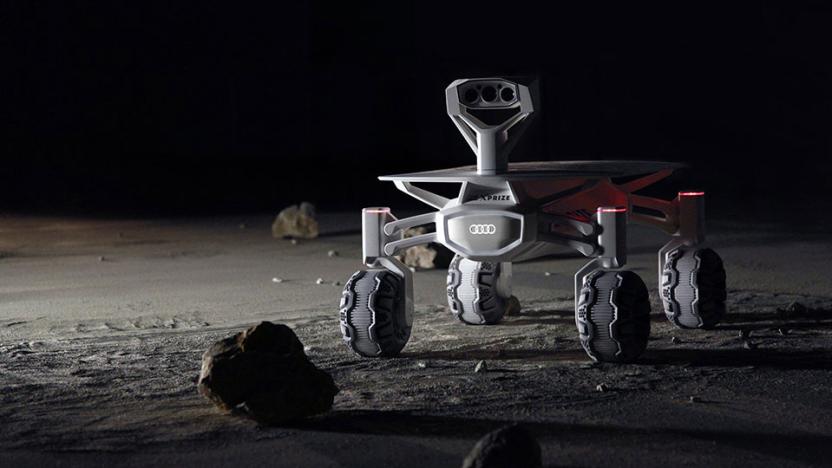GoogleLunarXPrize
Latest

The Google XPrize moonshot is a step closer to reality
An Israeli team competing in the Google Lunar XPrize has secured a launch contract to send its rover to the Moon. Xprize is offering $20 million to the first team to land a rover on the moon, travel 500 meters, and transmit HD video and images back to earth. SpaceIL, the Israeli team in question, has signed with Spaceflight Industries, a company which specializes in space "rideshares." The deal means that SpaceIL's rover will likely be hitching a lift aboard a SpaceX Falcon 9 rocket alongside commercial satellites -- and possibly even other XPrize contestants -- in 2017.

Audi is helping to make a moon rover for Google's Lunar Xprize
In a possible bid to make the most stylish entry yet for Google's Lunar XPRIZE, Audi has announced that it's teaming up with Part-Time Scientists, a German team working to put its rover on the moon. The carmaker says it's providing the Quattro's four-wheel drive tech, as well as expertise in lightweight construction and piloted driving. It's also getting a handy chunk of advertising, as the rover will now be called the Audi lunar Quattro moon rover -- in case you forget who helped.

Two Xprize rivals will share a trip to the Moon
Just because the Google Lunar Xprize is hotly contested doesn't mean that the competitors always have to be at each other's throats. Astrobotic and Hakuto have announced a partnership that will have Hakuto's rovers (Moonraker and Tetris) "piggyback" on Astrobotic's lander when it hopefully reaches the Moon in the second half of 2016. The two sides will still compete when they touch down, but they're setting it up as a race -- during a conference call, Astrobotic noted that it would wait for the other rovers to give them a fair shot and get some extra camera footage. The new allies aren't saying exactly how they'll split the prize if they win, but Hakuto can still get the lion's share.

Space Exploration After the Shuttle liveblog
America's space shuttle program may have come to an end when Atlantis was laid to rest at the Kennedy Space Center, but that's done nothing to dampen our interest in the universe through which we float. NASA's Curiosity captivates us with pictures and data from the Martian surface, and private ventures are popping up to replace shuttered, publicly funded programs. Join the SS Engadget for our panel on the future of space exploration -- introduced by Patrick O'Neill of the ISS, steered by our captain Brian Heater, and manned by Tom Rivellini of NASA's Jet Propulsion Laboratory, Alexandra Hall of Google's Lunar X PRIZE, and Michael Laine of the LiftPort Group. March 17, 2013 11:30 AM EST For a full list of Expand sessions, be sure to check out our event hub.

Live from Expand: Space Exploration After the Shuttle (video)
Space travel's undergone a major transformation over the past few decades, with the end of the shuttle and the rise of commercial companies. We'll be joined by representatives from Google Lunar X Prize, NASA, LiftPort and the International Space Station. March 17, 2013 12:30 PM EDT For a full list of Expand sessions, be sure to check out our event hub.

NASA accidentally improves weather forecasting with lunar dust-measuring lasers
Anyone that's ever tried to plan an outdoor activity in advance knows that weather forecasting is not an exact science, but the perpetual sky-watchers at NASA may have inadvertently found a way to improve these guesstimations. They have been testing a laser system for measuring lunar dust and soil kicked up by rocket exhausts, and while using precipitation as a substitute to calibrate the laser, they found they could measure the average size of raindrops passing through it. This value is estimated in current forecasting models, so plugging in some accurate numbers should make those predictions more reliable. The original mission hasn't been forgotten, though. Particles whipped up by landing rockets on the moon's surface could damage what was left behind by the Apollo missions, ruining its scientific and historic value. One of the laser sensors may find its way onto a craft vying for Google's X Prize, with the results used to determine where vessels can touch down whilst keeping a safe distance from Apollo landing sites. Although an accidental discovery, the system's other potential career in weather forecasting will also continue to be explored. Now, if only there was a way to make it rain and speed up the testing.

Polaris rover will travel to the Moon in search of polar resources, try to survive the long lunar night
The Polaris rover may look a little punk rock, but that mohawk is no fashion statement. It's for catching solar rays which shine almost horizontally at the Moon's north pole, a location Polaris is due to explore before 2016. Built by Astrobotic Technology, it'll be ferried aboard the SpaceX Falcon 9 rocket to our celestial companion, where it'll drill into the surface in search of ice. The company, spun out of the Carnegie Mellon University, hopes to identify resources at a depth of up to four feet that could be used to support manned Moon expeditions in the future. The plan is to complete the mission during a 10-day window of sunlight, digging at up to 100 sites over a three-mile stretch. However, if it can live through the harsh two-week-long nights, then it may continue to operate "indefinitely." NASA is backing the project, providing ice-prospecting gear and money, although Astrobotic hopes to get more cash for its work -- over $20 million from Google's Lunar X Prize. Right now, Polaris is a flight prototype and there are still improvements to be made, mainly on the software side, before it tackles the rough terrain. Check out the short video of its public unveiling below, although we don't think the soundtrack quite matches the hairdo.




